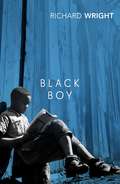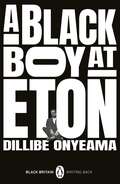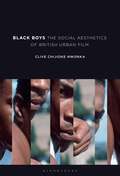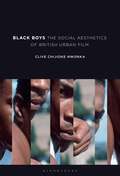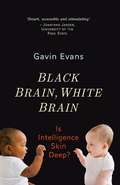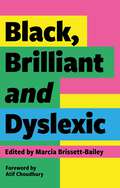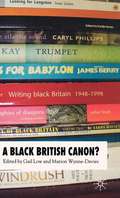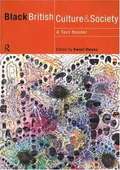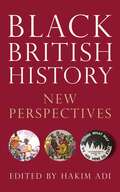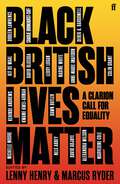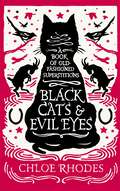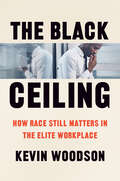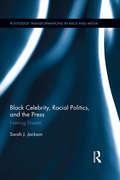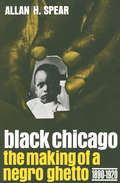- Table View
- List View
Black Boy (P. S. Series)
by Richard Wright'In Black Boy I found expressed, for the first time in my life, the sorrow, the rage, and the murderous bitterness which was eating up my life and lives of those around me. [Richard Wright's] work was an immense liberation and revelation for me. He became my ally and my witness, and alas! my father' - James BaldwinAt four years of age, Richard Wright set fire to his home; at five his father deserted the family; by six Richard was - temporarily - an alcoholic. Moved from home to home, from brick tenement to orphanage, he had had, by the age of twelve, only one year's formal education. It was in saloons, railroad yards and streets that he learned the facts about life under white subjection, about fear, hunger and hatred. Gradually he learned to play Jim Crow in order to survive in a world of white hostility, secretly satisfying his craving for books and knowledge until the time came when he could follow his dream of justice and opportunity in the north.
A Black Boy at Eton (Black Britain: Writing Back)
by Dillibe Onyeama'The story [Onyeama] had to tell was so gripping and shocking, it wouldn't let me go . . . A remarkably well-written memoir' Bernardine Evaristo, from the IntroductionDillibe was the second black boy to study at Eton - joining in 1965 - and the first to complete his education there. Written at just 21, this is a deeply personal, revelatory account of the racism he endured during his time as a student at the prestigious institution. He tells in vivid detail of his own background as the son of a Nigerian judge at the International Court of Justice at The Hague, of his arrival at the school, of the curriculum, of his reception by other boys (and masters), and of his punishments. He tells, too, of the cruel racial prejudice and his reactions to it, and of the alienation and stereotyping he faced at such a young age. A Black Boy at Eton is a searing, ground-breaking book displaying the deep psychological effects of colonialism and racism.A title in the Black Britain: Writing Back series - selected by Booker Prize-winning author Bernardine Evaristo, this series rediscovers and celebrates pioneering books depicting black Britain that remap the nation.
Black Boys: The Social Aesthetics of British Urban Film
by Clive Chijioke NwonkaIn Black Boys: The Aesthetics of British Urban Film, Nwonka offers the first dedicated analysis of Black British urban cinematic and televisual representation as a textual encounter with Blackness, masculinity and urban identity where the generic construction of images and narratives of Black urbanity is informed by the (un)knowable allure of Black urban Otherness. Foregrounding the textual Black urban identity as a historical formation, and drawing on a range of theoretical frameworks that allow for an examination of the emergence and continued social, cultural and industrial investment in the fictitious and non-fictitious images of Black urban identities and geographies, Nwonka convenes a dialogue between the disciplines of Film and Television Studies, Philosophy, Cultural Studies, Black Studies, Sociology and Criminology. Here, Nwonka ventures beyond what can be understood as the perennial and simplistic optic of racial stereotype in order to advance a more expansive reading of the Black British urban text as the outcome of a complex conjunctural interaction between social phenomena, cultural policy, political discourse and the continuously shifting politics of Black representation. Through the analysis of a number of texts and political and socio-cultural moments, Nwonka identifies Black urban textuality as conditioned by a bidirectionality rooted in historical and contemporary questions of race, racism and anti-Blackness but equally attentive to the social dynamics that render the screen as a site of Black recognition, authorship and authenticity. Analysed in the context of realism, social and political allegory, urban multiculture, Black corporeality and racial, gender and sexual politics, in integrating such considerations into the fabrics of a thematic reading of the Black urban text and through the writings of Stuart Hall, Paul Gilroy, Judith Butler and Derrida, Black Boys presents a critical rethinking of the contextual and aesthetic factors in the visual constructions of Black urban identity.
Black Boys: The Social Aesthetics of British Urban Film
by Clive Chijioke NwonkaIn Black Boys: The Aesthetics of British Urban Film, Nwonka offers the first dedicated analysis of Black British urban cinematic and televisual representation as a textual encounter with Blackness, masculinity and urban identity where the generic construction of images and narratives of Black urbanity is informed by the (un)knowable allure of Black urban Otherness. Foregrounding the textual Black urban identity as a historical formation, and drawing on a range of theoretical frameworks that allow for an examination of the emergence and continued social, cultural and industrial investment in the fictitious and non-fictitious images of Black urban identities and geographies, Nwonka convenes a dialogue between the disciplines of Film and Television Studies, Philosophy, Cultural Studies, Black Studies, Sociology and Criminology. Here, Nwonka ventures beyond what can be understood as the perennial and simplistic optic of racial stereotype in order to advance a more expansive reading of the Black British urban text as the outcome of a complex conjunctural interaction between social phenomena, cultural policy, political discourse and the continuously shifting politics of Black representation. Through the analysis of a number of texts and political and socio-cultural moments, Nwonka identifies Black urban textuality as conditioned by a bidirectionality rooted in historical and contemporary questions of race, racism and anti-Blackness but equally attentive to the social dynamics that render the screen as a site of Black recognition, authorship and authenticity. Analysed in the context of realism, social and political allegory, urban multiculture, Black corporeality and racial, gender and sexual politics, in integrating such considerations into the fabrics of a thematic reading of the Black urban text and through the writings of Stuart Hall, Paul Gilroy, Judith Butler and Derrida, Black Boys presents a critical rethinking of the contextual and aesthetic factors in the visual constructions of Black urban identity.
Black Brain, White Brain: Is Intelligence Skin Deep?
by Gavin EvansBy far the most important book yet written to systematically debunk society's lingering attachments to race science and its pet topics of intelligence, genetics and civilization.' - Jonathan Jansen, University of Free State Racist thinking - that intelligence is influenced by racial origin - was part of mainstream science a century ago and, surprisingly, is still endorsed by maverick scientists at some of the world's most respectable institutions. The myths being perpetuated on genetics, race, IQ and general intelligence are what Black Brain, White Brain challenges - precisely, systematically and in painstaking detail. In this immensely readable book Gavin Evans tackles highly complex subjects, from the origin of humans and the genesis of intelligence to athletic performance and genes, IQ and cleverness, in a fluent and engaging style that makes science accessible and the facts absorbing. Carefully balancing claims, testing dodgy propositions and presenting fairly the theories of modern scientists and evolutionary psychologists, Evans shows just how uniform we are, genetically, as a species and that it's mainly the environment we grow up and live in that's the determining factor.
Black, Brilliant and Dyslexic: Neurodivergent Heroes Tell their Stories
by Marcia Brissett-Bailey'My book showcases positive role models for black people and those within our wider dyslexic community and society, to inspire current and future generations.'This is a raw, honest and enlightening collection of experiences, across the black and dyslexic community, giving an intersectional perspective on topics including the education system, the workplace, daily life and entrepreneurship. These stories highlight the challenges, progress, successes and contributions of the black and dyslexic community, helping others to find their voice, feel empowered and be proud of their differences.It charts journeys from early childhood through to adulthood and, despite the lack of representation within the public arena, how black dyslexic people of all ages are changing the world.Raising awareness, breaking silences and tackling the stigma around dyslexia and the difficulties stemming from a lack of support. Contributors share how they tackled their unique adversities and provide practical tips for others to live proudly at the intersection of blackness and dyslexia.
Black, Brilliant and Dyslexic: Neurodivergent Heroes Tell their Stories
by Marcia Brissett-Bailey Atif Choudhury'My book showcases positive role models for black people and those within our wider dyslexic community and society, to inspire current and future generations.'This is a raw, honest and enlightening collection of experiences, across the black and dyslexic community, giving an intersectional perspective on topics including the education system, the workplace, daily life and entrepreneurship. These stories highlight the challenges, progress, successes and contributions of the black and dyslexic community, helping others to find their voice, feel empowered and be proud of their differences.It charts journeys from early childhood through to adulthood and, despite the lack of representation within the public arena, how black dyslexic people of all ages are changing the world.Raising awareness, breaking silences and tackling the stigma around dyslexia and the difficulties stemming from a lack of support. Contributors share how they tackled their unique adversities and provide practical tips for others to live proudly at the intersection of blackness and dyslexia.
A Black British Canon?
by G. Low M. Wynne-DaviesThis much-needed collection examines the formation of a black British canon including writers, dramatists, film-makers and artists. Contributors including John McLeod, Michael McMillan, Mike Phillips and Alison Donnell discuss the textual, political and cultural history of black British and the term 'black British' itself.
Black British Culture and Society: A Text Reader (PDF)
by Kwesi OwusuBlack British Culture and Society brings together in one indispensable volume key writings on the Black community in Britain, from the 'Windrush' immigrations of the late 1940s and 1950s to contemporary multicultural Britain. Combining classic writings on Black British life with new, specially commissioned articles, Black British Culture and Society records the history of the post-war African and Caribbean diaspora, tracing the transformations of Black culture in British society. Black British Culture and Society explores key facets of the Black experience, charting Black Britons' struggles to carve out their own identity and place in an often hostile society. The articles reflect the rich diversity of the Black British experience, addressing economic and social issues such as health, religion, education, feminism, old age, community and race relations, as well as Black culture and the arts, with discussions of performance, carnival, sport, style, literature, theatre, art and film-making. The contributors examine the often tense relationship between successful Black public figures and the media, and address the role of the Black intellectual in public life. Featuring interviews with noted Black artists and writers such as Aubrey Williams, Mustapha Matura and Caryl Phillips, and including articles from key contemporary thinkers, such as Stuart Hall, A. Sivanandan, Paul Gilroy and Henry Louis Gates, Black British Culture and Society provides a rich resource of analysis, critique and comment on the Black community's distinctive contribution to cultural life in Britain today. Black British Culture and Society brings together in one indispensable volume key writings on the Black community in Britain, from the 'Windrush' immigrations of the late 1940s and 1950s to contemporary multicultural Britain. Combining classic writings on Black British life with new, specially commissioned articles, Black British Culture and Society records the history of the post-war African and Caribbean diaspora, tracing the transformations of Black culture in British society. Black British Culture and Society explores key facets of the Black experience, charting Black Britons' struggles to carve out their own identity and place in an often hostile society. The articles reflect the rich diversity of the Black British experience, addressing economic and social issues such as health, religion, education, feminism, old age, community and race relations, as well as Black culture and the arts, with discussions of performance, carnival, sport, style, literature, theatre, art and film-making. The contributors examine the often tense relationship between successful Black public figures and the media, and address the role of the Black intellectual in public life. Featuring interviews with noted Black artists and writers such as Aubrey Williams, Mustapha Matura and Caryl Phillips, and including articles from key contemporary thinkers, such as Stuart Hall, A. Sivanandan, Paul Gilroy and Henry Louis Gates, Black British Culture and Society provides a rich resource of analysis, critique and comment on the Black community's distinctive contribution to cultural life in Britain today.
Black British History: New Perspectives (Blackness in Britain)
by Hakim AdiFor over 1500 years before the Empire Windrush docked on British shores, people of African descent have played a significant and far-ranging role in the country's history, from the African soldiers on Hadrian's Wall to the Black British intellectuals who made London a hub of radical, Pan-African ideas. But while there has been a growing interest in this history, there has been little recognition of the sheer breadth and diversity of the Black British experience, until now.This collection combines the latest work from both established and emerging scholars of Black British history. It spans the centuries from the first Black Britons to the latest African migrants, covering everything from Africans in Tudor England to the movement for reparations, and the never ending struggles against racism in between.An invaluable resource for both future scholarship and those looking for a useful introduction to Black British history, Black British History: New Perspectives has the potential to transform our understanding of Britain, and of its place in the world.
Black British History: New Perspectives (Blackness in Britain)
by Hakim AdiFor over 1500 years before the Empire Windrush docked on British shores, people of African descent have played a significant and far-ranging role in the country's history, from the African soldiers on Hadrian's Wall to the Black British intellectuals who made London a hub of radical, Pan-African ideas. But while there has been a growing interest in this history, there has been little recognition of the sheer breadth and diversity of the Black British experience, until now.This collection combines the latest work from both established and emerging scholars of Black British history. It spans the centuries from the first Black Britons to the latest African migrants, covering everything from Africans in Tudor England to the movement for reparations, and the never ending struggles against racism in between.An invaluable resource for both future scholarship and those looking for a useful introduction to Black British history, Black British History: New Perspectives has the potential to transform our understanding of Britain, and of its place in the world.
Black British Lives Matter: A Clarion Call for Equality
by Lenny Henry Marcus RyderFeaturing essays from David Olusoga, Dawn Butler MP, Kit de Waal, Kwame Kwei-Armah, and many more.In response to the international outcry at George Floyd's death, Lenny Henry and Marcus Ryder have commissioned this collection of essays to discuss how and why we need to fight for Black lives to matter - not just for Black people but for society as a whole.Recognising Black British experience within the Black Lives Matter movement, nineteen prominent Black figures explain why Black lives should be celebrated when too often they are undervalued. Drawing from personal experience, they stress how Black British people have unique perspectives and experiences that enrich British society and the world; how Black lives are far more interesting and important than the forces that try to limit it."We achieve everything not because we are superhuman. We achieve the things we achieve because we are human. Our strength does not come from not having any weaknesses, our strength comes from overcoming them" Doreen Lawrence."I always presumed racism would always be here, that it was a given. But the truth is, it was not always here, it was invented." David Olusoga"Our identity and experience will shape every story, bleed into every poem, inform every essay whether it's about Black 'issues' or not" Kit de Waal
The Black Butterfly: The Harmful Politics of Race and Space in America
by Lawrence T. BrownThe world gasped in April 2015 as Baltimore erupted and Black Lives Matter activists, incensed by Freddie Gray's brutal death in police custody, shut down highways and marched on city streets. In The Black Butterfly—a reference to the fact that Baltimore's majority-Black population spreads out on both sides of the coveted strip of real estate running down the center of the city like a butterfly's wings—Lawrence T. Brown reveals that ongoing historical trauma caused by a combination of policies, practices, systems, and budgets is at the root of uprisings and crises in hypersegregated cities around the country. Putting Baltimore under a microscope, Brown looks closely at the causes of segregation, many of which exist in current legislation and regulatory policy despite the common belief that overtly racist policies are a thing of the past. Drawing on social science research, policy analysis, and archival materials, Brown reveals the long history of racial segregation's impact on health, from toxic pollution to police brutality. Beginning with an analysis of the current political moment, Brown delves into how Baltimore's history influenced actions in sister cities like St. Louis and Cleveland, as well as its adoption of increasingly oppressive techniques from cities like Chicago. But there is reason to hope. Throughout the book, Brown offers a clear five-step plan for activists, nonprofits, and public officials to achieve racial equity. Not content to simply describe and decry urban problems, Brown offers up a wide range of innovative solutions to help heal and restore redlined Black neighborhoods, including municipal reparations. Persuasively arguing that because urban apartheid was intentionally erected it can be intentionally dismantled, The Black Butterfly demonstrates that America cannot reflect that Black lives matter until we see how Black neighborhoods matter.
The Black Butterfly: The Harmful Politics of Race and Space in America
by Lawrence T. BrownThe world gasped in April 2015 as Baltimore erupted and Black Lives Matter activists, incensed by Freddie Gray's brutal death in police custody, shut down highways and marched on city streets. In The Black Butterfly—a reference to the fact that Baltimore's majority-Black population spreads out on both sides of the coveted strip of real estate running down the center of the city like a butterfly's wings—Lawrence T. Brown reveals that ongoing historical trauma caused by a combination of policies, practices, systems, and budgets is at the root of uprisings and crises in hypersegregated cities around the country. Putting Baltimore under a microscope, Brown looks closely at the causes of segregation, many of which exist in current legislation and regulatory policy despite the common belief that overtly racist policies are a thing of the past. Drawing on social science research, policy analysis, and archival materials, Brown reveals the long history of racial segregation's impact on health, from toxic pollution to police brutality. Beginning with an analysis of the current political moment, Brown delves into how Baltimore's history influenced actions in sister cities like St. Louis and Cleveland, as well as its adoption of increasingly oppressive techniques from cities like Chicago. But there is reason to hope. Throughout the book, Brown offers a clear five-step plan for activists, nonprofits, and public officials to achieve racial equity. Not content to simply describe and decry urban problems, Brown offers up a wide range of innovative solutions to help heal and restore redlined Black neighborhoods, including municipal reparations. Persuasively arguing that because urban apartheid was intentionally erected it can be intentionally dismantled, The Black Butterfly demonstrates that America cannot reflect that Black lives matter until we see how Black neighborhoods matter.
Black Camelot: African-American Culture Heroes in Their Times, 1960-1980
by William L. Van DeburgIn the wake of the Kennedy era, a new kind of ethnic hero emerged within African-American popular culture. Uniquely suited to the times, burgeoning pop icons projected the values and beliefs of the Civil Rights and Black Power movements, and reflected both the possibility and the actuality of a rapidly changing American landscape. In Black Camelot, William Van Deburg examines the dynamic rise of these new black champions, the social and historical contexts in which they flourished, and their powerful impact on the African-American community. "Van Deburg manages the enviable feat of writing with flair within a standardized academic framework, covering politics, social issues and entertainment with equal aplomb."—Jonathan Pearl, Jazz Times "[A] fascinating, thorough account of how African-American icons of the 1960s and '70s have changed the course of American history. . . . An in-depth, even-tempered analysis. . . . Van Deburg's witty, lively and always grounded style entertains while it instructs."—Publishers Weekly
Black Camelot: African-American Culture Heroes in Their Times, 1960-1980
by William L. Van DeburgIn the wake of the Kennedy era, a new kind of ethnic hero emerged within African-American popular culture. Uniquely suited to the times, burgeoning pop icons projected the values and beliefs of the Civil Rights and Black Power movements, and reflected both the possibility and the actuality of a rapidly changing American landscape. In Black Camelot, William Van Deburg examines the dynamic rise of these new black champions, the social and historical contexts in which they flourished, and their powerful impact on the African-American community. "Van Deburg manages the enviable feat of writing with flair within a standardized academic framework, covering politics, social issues and entertainment with equal aplomb."—Jonathan Pearl, Jazz Times "[A] fascinating, thorough account of how African-American icons of the 1960s and '70s have changed the course of American history. . . . An in-depth, even-tempered analysis. . . . Van Deburg's witty, lively and always grounded style entertains while it instructs."—Publishers Weekly
Black Camelot: African-American Culture Heroes in Their Times, 1960-1980
by William L. Van DeburgIn the wake of the Kennedy era, a new kind of ethnic hero emerged within African-American popular culture. Uniquely suited to the times, burgeoning pop icons projected the values and beliefs of the Civil Rights and Black Power movements, and reflected both the possibility and the actuality of a rapidly changing American landscape. In Black Camelot, William Van Deburg examines the dynamic rise of these new black champions, the social and historical contexts in which they flourished, and their powerful impact on the African-American community. "Van Deburg manages the enviable feat of writing with flair within a standardized academic framework, covering politics, social issues and entertainment with equal aplomb."—Jonathan Pearl, Jazz Times "[A] fascinating, thorough account of how African-American icons of the 1960s and '70s have changed the course of American history. . . . An in-depth, even-tempered analysis. . . . Van Deburg's witty, lively and always grounded style entertains while it instructs."—Publishers Weekly
The Black Campus Movement: Black Students and the Racial Reconstitution of Higher Education, 1965–1972 (Contemporary Black History)
by Ibram X. KendiThis book provides the first national study of this intense and challenging struggle which disrupted and refashioned institutions in almost every state. It also illuminates the context for one of the most transformative educational movements in American history through a history of black higher education and black student activism before 1965.
Black Cats and Evil Eyes: A Book of Old-Fashioned Superstitions
by Chloe RhodesThis collection investigates the origins of our most intriguing old-fashioned superstitions, many of which we still find ourselves abiding by today.Hundreds of the beliefs passed down through the generations have their foundations in our ancestors' efforts to ward off evil, which they blamed for hardship, illness and injustice in times when life was, as often as not, 'nasty, brutish and short'. Black Cats and Evil Eyes sets these superstitions in their historical and social context, explaining how fear of the Devil, demons, evil spirits and witchcraft drove people to arm themselves with rituals and talismans to repel dark forces and allow them to live long and healthy lives.In examining many of our common superstitions, this book illuminates the customs, beliefs and practices that link us to an ancient, and often darker, human past.
The Black Ceiling: How Race Still Matters in the Elite Workplace
by Kevin WoodsonA revelatory assessment of workplace inequality in high-status jobs that focuses on a new explanation for a pernicious problem: racial discomfort. America’s elite law firms, investment banks, and management consulting firms are known for grueling hours, low odds of promotion, and personnel practices that push out any employees who don’t advance. While most people who begin their careers in these institutions leave within several years, work there is especially difficult for Black professionals, who exit more quickly and receive far fewer promotions than their White counterparts, hitting a “Black ceiling.” Sociologist and law professor Kevin Woodson knows firsthand what life at a top law firm feels like as a Black man. Examining the experiences of more than one hundred Black professionals at prestigious firms, Woodson discovers that their biggest obstacle in the workplace isn’t explicit bias but racial discomfort, or the unease Black employees feel in workplaces that are steeped in Whiteness. He identifies two types of racial discomfort: social alienation, the isolation stemming from the cultural exclusion Black professionals experience in White spaces, and stigma anxiety, the trepidation they feel over the risk of discriminatory treatment. While racial discomfort is caused by America’s segregated social structures, it can exist even in the absence of racial discrimination, which highlights the inadequacy of the unconscious bias training now prevalent in corporate workplaces. Firms must do more than prevent discrimination, Woodson explains, outlining the steps that firms and Black professionals can take to ease racial discomfort. Offering a new perspective on a pressing social issue, The Black Ceiling is a vital resource for leaders at preeminent firms, Black professionals and students, managers within mostly White organizations, and anyone committed to cultivating diverse workplaces.
The Black Ceiling: How Race Still Matters in the Elite Workplace
by Kevin WoodsonA revelatory assessment of workplace inequality in high-status jobs that focuses on a new explanation for a pernicious problem: racial discomfort. America’s elite law firms, investment banks, and management consulting firms are known for grueling hours, low odds of promotion, and personnel practices that push out any employees who don’t advance. While most people who begin their careers in these institutions leave within several years, work there is especially difficult for Black professionals, who exit more quickly and receive far fewer promotions than their White counterparts, hitting a “Black ceiling.” Sociologist and law professor Kevin Woodson knows firsthand what life at a top law firm feels like as a Black man. Examining the experiences of more than one hundred Black professionals at prestigious firms, Woodson discovers that their biggest obstacle in the workplace isn’t explicit bias but racial discomfort, or the unease Black employees feel in workplaces that are steeped in Whiteness. He identifies two types of racial discomfort: social alienation, the isolation stemming from the cultural exclusion Black professionals experience in White spaces, and stigma anxiety, the trepidation they feel over the risk of discriminatory treatment. While racial discomfort is caused by America’s segregated social structures, it can exist even in the absence of racial discrimination, which highlights the inadequacy of the unconscious bias training now prevalent in corporate workplaces. Firms must do more than prevent discrimination, Woodson explains, outlining the steps that firms and Black professionals can take to ease racial discomfort. Offering a new perspective on a pressing social issue, The Black Ceiling is a vital resource for leaders at preeminent firms, Black professionals and students, managers within mostly White organizations, and anyone committed to cultivating diverse workplaces.
Black Celebrity, Racial Politics, and the Press: Framing Dissent (Routledge Transformations in Race and Media)
by Sarah J. JacksonShifting understandings and ongoing conversations about race, celebrity, and protest in the twenty-first century call for a closer examination of the evolution of dissent by black celebrities and their reception in the public sphere. This book focuses on the way the mainstream and black press have covered cases of controversial political dissent by African American celebrities from Paul Robeson to Kanye West. Jackson considers the following questions: 1) What unique agency is available to celebrities with racialized identities to present critiques of American culture? 2) How have journalists in both the mainstream and black press limited or facilitated this agency through framing? What does this say about the varying role of journalism in American racial politics? 3) How have framing trends regarding these figures shifted from the mid-twentieth century to the twenty-first century? Through a series of case studies that also includes Eartha Kitt, Sister Souljah, and Mahmoud Abdul-Rauf, Jackson illustrates the shifting public narratives and historical moments that both limit and enable African American celebrities in the wake of making public politicized statements that critique the accepted racial, economic, and military systems in the United States.
Black Celebrity, Racial Politics, and the Press: Framing Dissent (Routledge Transformations in Race and Media)
by Sarah J. JacksonShifting understandings and ongoing conversations about race, celebrity, and protest in the twenty-first century call for a closer examination of the evolution of dissent by black celebrities and their reception in the public sphere. This book focuses on the way the mainstream and black press have covered cases of controversial political dissent by African American celebrities from Paul Robeson to Kanye West. Jackson considers the following questions: 1) What unique agency is available to celebrities with racialized identities to present critiques of American culture? 2) How have journalists in both the mainstream and black press limited or facilitated this agency through framing? What does this say about the varying role of journalism in American racial politics? 3) How have framing trends regarding these figures shifted from the mid-twentieth century to the twenty-first century? Through a series of case studies that also includes Eartha Kitt, Sister Souljah, and Mahmoud Abdul-Rauf, Jackson illustrates the shifting public narratives and historical moments that both limit and enable African American celebrities in the wake of making public politicized statements that critique the accepted racial, economic, and military systems in the United States.
Black Chicago: The Making of a Negro Ghetto, 1890-1920
by Allan H. SpearAllan Spear explores here the history of a major Negro community during a crucial thirty-year period when a relatively fluid patter of race relations gave way to a rigid system of segregation and discrimination. This is the first historical study of the ghetto made famous by the sociological classics of St. Clair Drake, E. Franklin Frazier, and others—by the novels of Richard Wright, and by countless blues songs. It was this ghetto that Martin Luther King, Jr., chose to focus on when he turned attention to the racial injustices of the North. Spear, by his objective treatment of the results of white racism, gives an effective, timely reminder of the serious urban problems that are the legacy of prejudice.
Black Chicago: The Making of a Negro Ghetto, 1890-1920
by Allan H. SpearAllan Spear explores here the history of a major Negro community during a crucial thirty-year period when a relatively fluid patter of race relations gave way to a rigid system of segregation and discrimination. This is the first historical study of the ghetto made famous by the sociological classics of St. Clair Drake, E. Franklin Frazier, and others—by the novels of Richard Wright, and by countless blues songs. It was this ghetto that Martin Luther King, Jr., chose to focus on when he turned attention to the racial injustices of the North. Spear, by his objective treatment of the results of white racism, gives an effective, timely reminder of the serious urban problems that are the legacy of prejudice.
